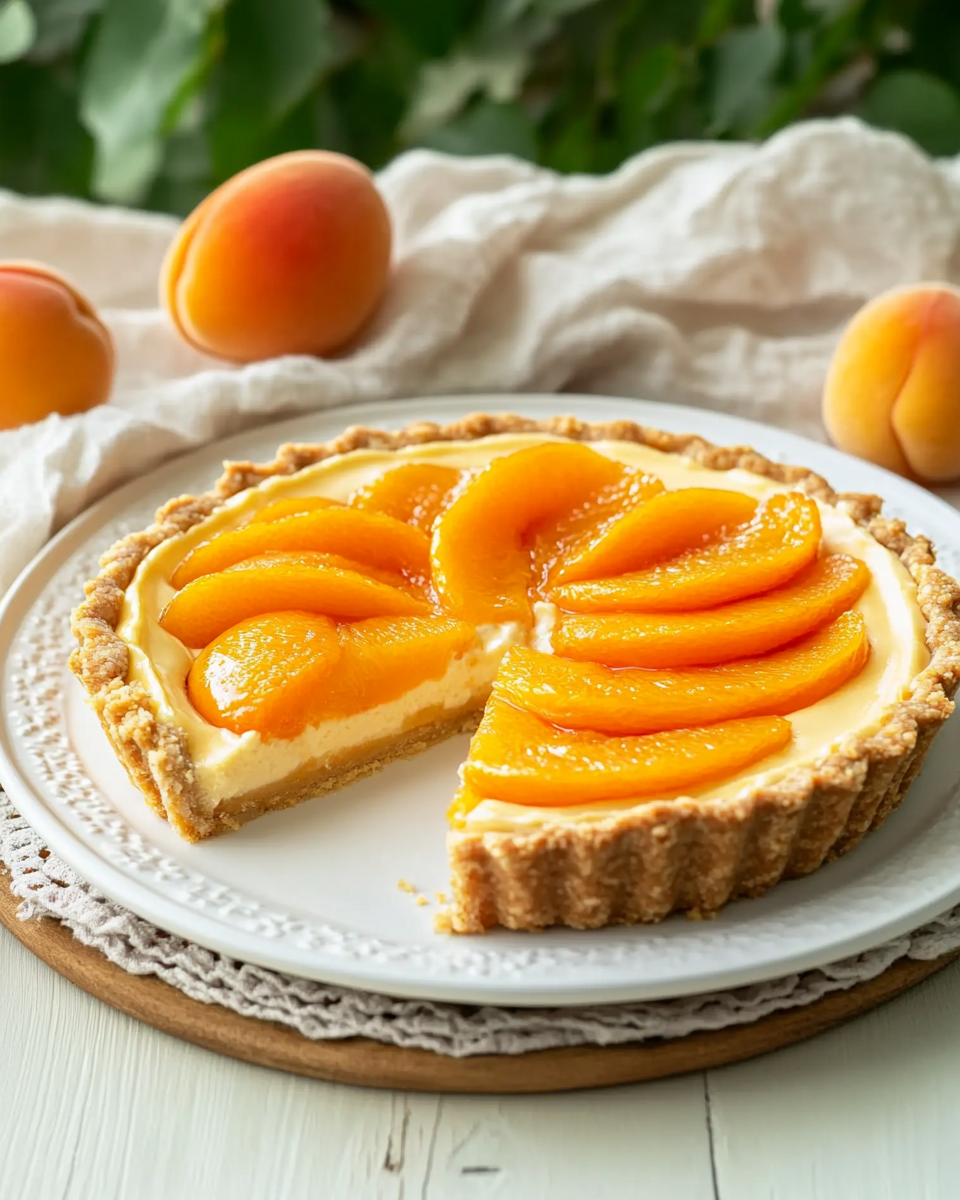The apricot cheesecake tart is a delightful dessert that brings together the creamy richness of classic cheesecake and the bright, fruity flavor of apricots in a crisp, buttery tart shell. This elegant treat is perfect for those who enjoy the smooth texture of cheesecake but want a lighter, more refreshing twist with the addition of seasonal fruit. Its balance of sweet and tangy notes makes it a crowd-pleaser for gatherings, special occasions, or simply as a satisfying finish to any meal. Easy to customize and visually stunning, the apricot cheesecake tart is both a feast for the eyes and the palate.
FULL RECIPE
Ingredients
- 1 1/4 cups all-purpose flour
- 1/4 cup granulated sugar
- 1/2 cup unsalted butter, chilled and cut into cubes
- 1 large egg yolk
- 2 tablespoons cold water
- 8 oz cream cheese, softened
- 1/3 cup granulated sugar
- 1 large egg
- 1/2 teaspoon vanilla extract
- 1/4 cup sour cream
- 1/2 cup apricot preserves
- Fresh apricot slices (optional, for garnish)
Directions
- Preheat oven to 350°F (175°C).
- In a bowl, combine flour and 1/4 cup sugar. Cut in butter until mixture resembles coarse crumbs.
- Add egg yolk and water; mix until dough forms. Press dough into a 9-inch tart pan.
- Bake crust for 10 minutes. Remove from oven and let cool slightly.
- In another bowl, beat cream cheese and 1/3 cup sugar until smooth. Add egg, vanilla, and sour cream; mix well.
- Pour filling into tart shell. Bake for 20–25 minutes, or until set.
- Remove tart and cool completely.
- Warm apricot preserves slightly, then spread over cooled cheesecake filling.
- Garnish with fresh apricot slices if desired. Chill before serving.
Nutritional Information
- Calories: 310 per slice
- Total Fat: 18g
- Saturated Fat: 11g
- Cholesterol: 90mg
- Sodium: 160mg
- Total Carbohydrates: 32g
- Dietary Fiber: 1g
- Sugars: 18g
- Protein: 5g
- Vitamin A: 15% DV
- Vitamin C: 4% DV
- Calcium: 6% DV
- Iron: 6% DV
History and Origins of Apricot Cheesecake Tart
The apricot cheesecake tart combines two beloved dessert traditions: the creamy richness of cheesecake and the bright, fruity flavors of apricot. Cheesecake itself dates back to ancient Greece, where it was considered a nourishing treat for athletes. Over centuries, cheesecake recipes evolved globally, with many regions adding their own unique twists. The addition of apricot in tart form likely comes from European influences, particularly French patisserie, where fruit tarts and cheesecakes are both staples. The tart version offers a crisp, buttery crust that contrasts beautifully with the smooth cream cheese filling and the tangy apricot topping, creating a harmonious blend of textures and flavors.
Why Apricots Work Perfectly in Cheesecake
Apricots have a delicate balance of sweetness and tartness, making them an ideal fruit to pair with the rich, creamy texture of cheesecake. Their natural acidity cuts through the dense cream cheese filling, refreshing the palate and preventing the dessert from feeling too heavy. Additionally, apricots bring a vibrant orange hue and subtle floral notes that enhance the visual appeal and complexity of the tart. When warmed or preserved, apricots release a luscious syrup that seeps into the cheesecake, adding moisture and depth to every bite.
The Role of the Tart Crust
The tart crust is a critical element in the apricot cheesecake tart. Typically made from a combination of flour, butter, and sugar, the crust acts as a sturdy base that supports the creamy filling while contributing a crisp texture. Unlike a traditional cheesecake crust, which often uses crushed cookies or graham crackers, a tart crust is more refined and flaky. Its slight sweetness and buttery flavor complement the cheesecake without overpowering it. The crust’s structure also ensures that the tart holds its shape well when sliced and served, providing an elegant presentation.
Variations of Apricot Cheesecake Tart
This recipe is versatile and can be customized in various ways to suit different tastes and occasions. Some variations include adding almond flour to the crust for a nutty flavor or mixing fresh apricot chunks into the cream cheese filling for added texture. Others might swap apricot preserves for a fresh apricot glaze or incorporate spices like cinnamon or ginger to add warmth. For a vegan or dairy-free option, cream cheese alternatives made from cashews or tofu can be used. These variations allow the apricot cheesecake tart to be adapted while maintaining its core appeal.
Seasonal Appeal and Serving Suggestions
Apricot cheesecake tart is particularly popular in late spring and summer, when fresh apricots are in season and at their peak flavor. Serving the tart slightly chilled accentuates its creamy texture and refreshing fruit topping, making it an ideal dessert for warm-weather gatherings. It pairs beautifully with light accompaniments such as whipped cream, a drizzle of honey, or a scoop of vanilla ice cream. For special occasions, garnishing with edible flowers or fresh mint leaves can elevate its presentation and add subtle fragrance.
Nutritional Aspects and Moderation
While apricot cheesecake tart is a delicious treat, it is also rich in calories, fats, and sugars due to its cream cheese and buttery crust. However, apricots provide some nutritional benefits, including vitamins A and C, dietary fiber, and antioxidants. Enjoying this dessert in moderation fits well within a balanced diet, especially when paired with fresh fruit or a light beverage like herbal tea. For those mindful of dietary restrictions, adjusting ingredients or portion sizes can help maintain indulgence without excess.
Cultural Significance and Occasions
Desserts like apricot cheesecake tart often find their place in cultural celebrations and family gatherings. In many European countries, fruit tarts are traditional treats during holidays and festivals, symbolizing abundance and the joys of seasonal harvest. This tart’s combination of rich creaminess and fresh fruit also makes it popular for birthdays, brunches, and casual dinner parties. Sharing a homemade apricot cheesecake tart can be a way to connect with loved ones and celebrate special moments with something both comforting and elegant.
Pairing Apricot Cheesecake Tart with Beverages
Choosing the right beverage can elevate the enjoyment of an apricot cheesecake tart. Light, slightly acidic wines such as Riesling or Moscato complement the tart’s fruity notes and creamy texture. For non-alcoholic options, herbal teas like chamomile or mint balance the richness without overpowering the palate. Coffee, especially with a mild roast, pairs well if you prefer a more robust contrast. Experimenting with beverage pairings allows you to tailor the dessert experience to different tastes and occasions.
Tips for Perfecting the Tart at Home
Achieving a perfect apricot cheesecake tart involves attention to detail. Ensuring the crust is well chilled before baking helps prevent shrinkage and creates a tender texture. Softening cream cheese to room temperature before mixing results in a smoother filling without lumps. Avoid overbaking the cheesecake filling to keep it creamy rather than dry or cracked. Lastly, gently warming apricot preserves before spreading helps create a glossy, even topping. These small tips improve the overall texture, flavor, and appearance of your tart.
Storing and Reheating the Tart
Proper storage maintains the freshness and flavor of the apricot cheesecake tart. It should be refrigerated and covered tightly with plastic wrap or in an airtight container to prevent drying out or absorbing other odors. The tart typically stays fresh for up to three days. For longer storage, it can be frozen, though texture may slightly change. To serve after refrigeration, let the tart sit at room temperature for 10–15 minutes or gently warm in a low oven to soften the filling and enhance flavors.
Healthier Ingredient Substitutions
For those looking to enjoy apricot cheesecake tart with fewer calories or less fat, there are several ingredient swaps. Using reduced-fat cream cheese or Greek yogurt can lighten the filling without sacrificing creaminess. The crust can be made with whole wheat flour or oat flour for added fiber and nutrients. Natural sweeteners like honey or maple syrup may replace some sugar for a more wholesome taste. These adjustments make the dessert more suitable for health-conscious individuals while preserving its delightful character.
The Art of Presentation
Presentation plays a big role in making apricot cheesecake tart appealing. A smooth, even layer of apricot glaze creates a shiny, attractive surface, while fresh apricot slices arranged in a fan or spiral pattern add elegance. Dusting the tart lightly with powdered sugar or garnishing with edible flowers can create a professional touch. Serving the tart on a decorative plate or with complementary garnishes enhances the dining experience and makes it visually inviting for guests or website visitors.
Conclusion
The apricot cheesecake tart is a sophisticated yet accessible dessert that perfectly blends creamy, tangy, and sweet flavors with a crisp crust. Its rich history, versatility, and vibrant appeal make it a favorite among dessert lovers, especially in warmer months when apricots shine. Whether served at festive occasions or enjoyed as a simple treat, this tart offers a delightful balance of textures and tastes. With a few thoughtful tips for preparation, storage, and presentation, it can become a standout recipe for any dessert repertoire.






